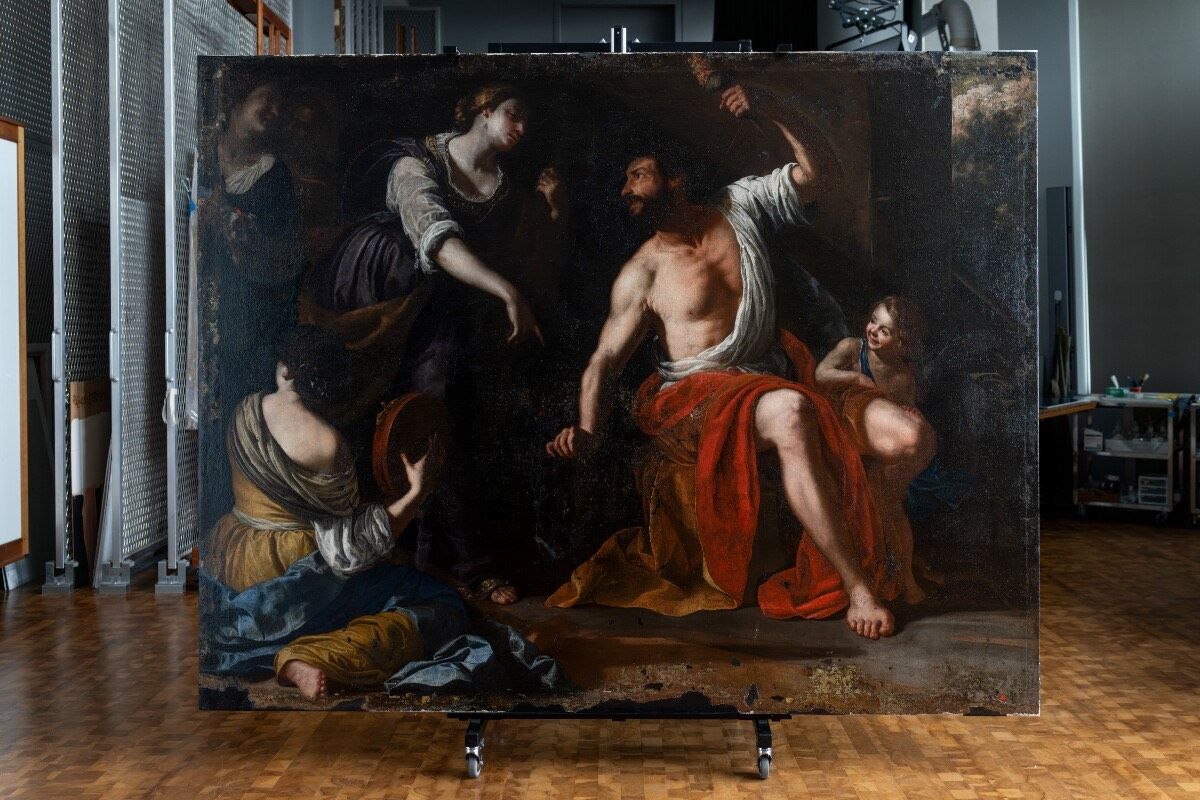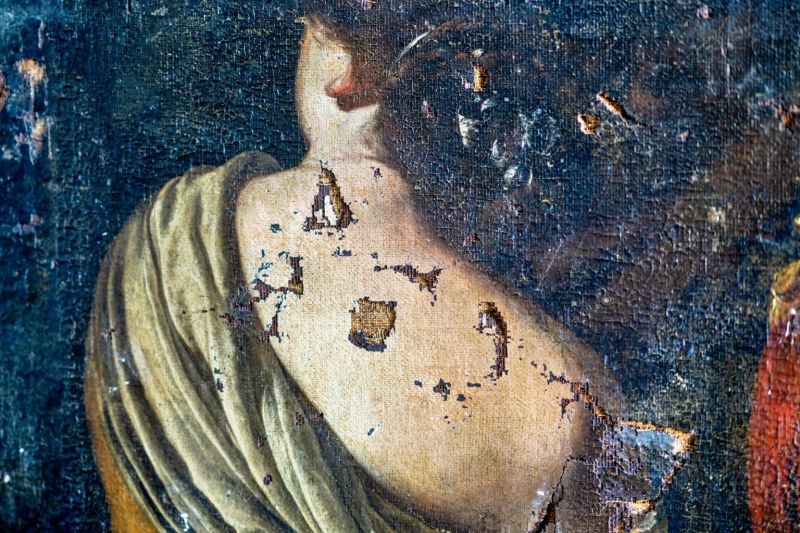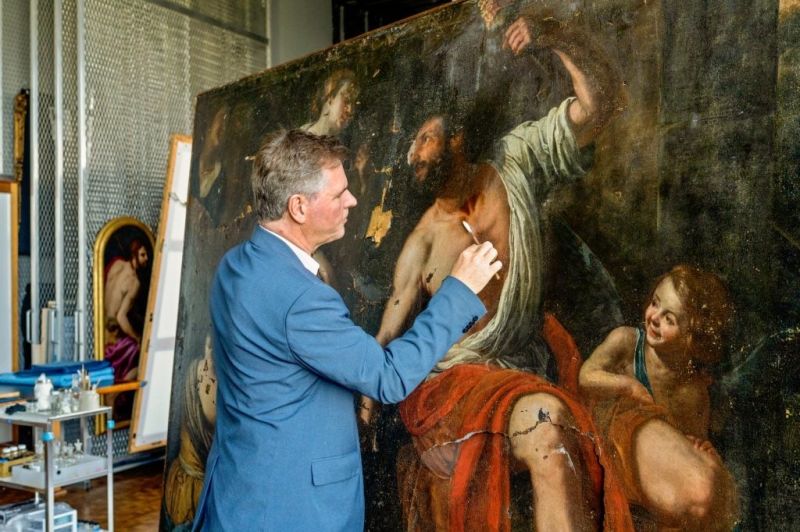
Miraculously saved from the Beirut port double explosion, a forgotten masterpiece by Artemisia Gentileschi from the Sursock Palace is reborn at the J. Paul Getty Museum in Los Angeles. Its restoration marks a landmark cultural moment—celebrating memory, resilience and the enduring legacy of female brilliance in Baroque art.
On August 4, 2020, at 6:07 PM, a devastating blast tore through the skies of Beirut. The shockwave obliterated the port, destroyed entire neighborhoods, claimed over 230 lives and left a haunting scene of ruin and disbelief. Among the many cultural treasures affected was Sursock Palace, a 19th-century Ottoman villa and historic family residence in Beirut. Its doors were blasted open, stained glass windows were shattered and parts of its private collection were deeply damaged.
Amid the destruction, a remarkable revival took place: Hercules and Omphale, a painting attributed to Artemisia Gentileschi—one of the earliest great female painters in Western art—once believed lost for centuries, has resurfaced. After three years of meticulous restoration, the masterpiece now dazzles at the J. Paul Getty Museum in Los Angeles. Its extraordinary journey from obscurity to brilliance embodies the resilience of art, the fragility of cultural heritage and the enduring legacy of an artist who defied the boundaries of her era.

Detail showing the damage caused by the explosion. © J. Paul Getty Trust
Hercules and Omphale was part of the private collection housed in Sursock Palace. When the explosion struck, the canvas was shredded, punctured, torn from its stretcher and buried beneath rubble, shattered glass and dust—a devastating pictorial ruin. Yet, Lebanese and international experts quickly recognized its restoration potential.
Lebanese art historian Gregory Buchakjian, who had studied two anonymous paintings from the Sursock family collection in his master’s thesis, published an article shortly after the blast in Apollo magazine. He highlighted the catastrophic damage to Lebanon’s cultural heritage and raised the possibility that these works could be attributed to Artemisia Gentileschi. This urgent alert captured global museum attention.
Through detailed stylistic comparisons, scientific analysis and historical research, specialists confirmed that Hercules and Omphale was indeed an original Gentileschi, signed by the artist and likely painted in Naples during the 1630s.
The painting was sent to the J. Paul Getty Museum in Los Angeles for restoration as part of a collaboration with Lebanese authorities. Restoration began in 2022, with the canvas in a severely compromised state. “It was one of the most complex projects of my career, but also one of the most rewarding,” said Ulrich Birkmaier, chief conservator at the Getty. Working alongside Italian expert Matteo Rossi Doria, he meticulously reconstructed the support by relining it with fresh fabric, reinforced the structure with a flexible stretcher, removed debris and layers of varnish, carefully cleaned the surface and restored missing details using X-ray analysis.

The museum’s chief conservator, Ulrich Birkmaier, examines the painting. © J. Paul Getty Trust
Some sections, completely destroyed, were painstakingly restored using Artemisia’s own techniques and visual language. These advanced methods revived the colors with renewed vibrancy, restored contours to their clarity and allowed the figures—Omphale, Hercules, Cupid—to reclaim their theatrical and symbolic presence.
A Scene of Power Reversal
The painting depicts a rarely explored mythological episode: Hercules, the ultimate symbol of masculine heroism, reduced to servitude by Omphale, Queen of Lydia. In a striking reversal of gender roles, Omphale wears the lion’s skin Hercules famously slew, while he holds a distaff—a traditional emblem of femininity and submission. Cupid, grinning mischievously, hovers above, adding ironic commentary to this inversion.
This subject choice is deeply significant. Artemisia Gentileschi—raped at 17 by her mentor and subjected to a humiliating public trial—made the portrayal of powerful women the core of her work. Paintings like Judith Beheading Holofernes, Susanna and the Elders and Cleopatra share a common message: women are agents of their own fate. Hercules and Omphale continues this tradition, exploring gender fluidity, power dynamics and the complex interplay of desire and dominance, with subtle sensuality and political nuance.
“This Neapolitan period is often misunderstood as a decline in Artemisia’s career, but it actually represents the pinnacle of her technical skill and artistic strategy,” says Davide Gasparotto, curator at the Getty Museum. After settling in Naples in 1630, Gentileschi established a dynamic workshop, tailored her work to aristocratic patrons and produced grand-scale compositions.
The rediscovery of Hercules and Omphale invites a fresh appraisal of this later phase of her career, long overshadowed by her early Roman masterpieces. It reveals Artemisia as a strategic, entrepreneurial and visionary artist—one who navigated patriarchal constraints to create work strikingly modern, centuries ahead of its time.
The restored painting now serves as the centerpiece of an exhibition at the Getty Center titled “Artemisia’s Strong Women: Rescuing a Masterpiece.” It is accompanied by other major works, including Bathsheba and David (loaned by the Columbus Museum of Art) and Self-Portrait as a Female Martyr ( belonging to a private collection ). Together, these works celebrate a trailblazing figure at the intersection of art history, feminism and cultural memory.
A Silent Legacy: Lady Yvonne Sursock Cochrane
The survival of this masterpiece is also a tribute to Lady Yvonne Sursock Cochrane, the last resident and guardian of Sursock Palace. A philanthropist and tireless advocate for Lebanese cultural preservation, she died just 17 days after the explosion, at the age of 98. The rescue and restoration of Hercules and Omphale serve as a silent homage to her lifelong dedication.
The exhibition will travel to Columbus before its highly anticipated return to Lebanon. Despite its spectacular restoration and global recognition, Hercules and Omphale ultimately belongs to Beirut. “We are honored to host this masterpiece, but it will return home,” affirms Timothy Potts, director of the J. Paul Getty Museum. “Its story embodies both the fragility of art and its extraordinary capacity to endure.”
Indeed, Artemisia and those who protected her legacy continue to speak across the centuries.





Comments